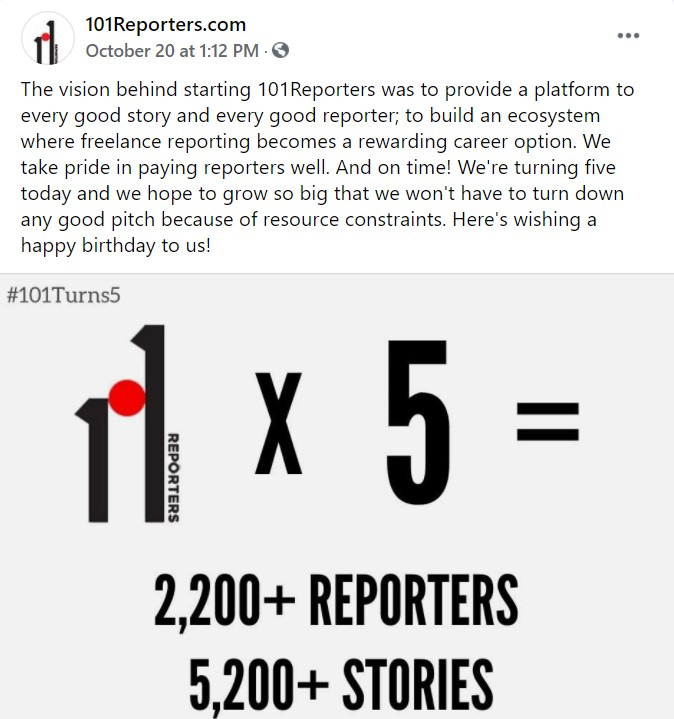“The purpose of starting 101 Reporters was to make sure that grassroots-reporters get the opportunities to tell stories that matter. Too often we see that any story, take any big story, I mean all big stories come from major cities: Delhi, Bombay, Bangalore. But it doesn't mean that nothing major is happening in India's villages. 67% of our 1.3 billion population lives in villages,” says Hemant Gairola, the News Editor at 101 Reporters, a network of freelance journalists that brings together hinterland reporters and big media houses. Hemant has been with the organisation since its inception and has gone through many roles in the last five years. He started as a reporter. Now he acts as a bridge between 101Reporters and their partner publications.
A 101Reporters story starts with a journalist from their networks pitching a story to the editors. Once a story gets approved, it’s then pitched to the partner publications. When a publication calls dibs on a story, the journalist is notified and the reporting begins. 101Reporters has now started publishing stories even on their own website: 101reporters.com

These stories get carried from the heartland to big platforms, with the journalist looped in the process throughout. It works for the publishers as they save on logistics and coordination. And it’s a great way for the rural stories and storytellers to find an established platform. In five years, they have told around 5,200 stories.
“But of course, there are story ideas that fail to pass muster or are simply not good enough, they kill right at the start. We reply to the reporters and we give them reasons, ‘that okay, for so and so reason, we are not approving your story ideas.’ And this is one of those parts where I think we stand apart from most of the publishers,” Hemant adds. Even after 101 Reporters approve a story pitch, not every story gets picked up by publishers. And that’s why to bridge this gap, they recently started their own website to publish stories that are important, that need to be told and which may not get picked up by publishers.
Hemant also has a piece of quick advice for freelancers as we delve into the success rate of freelance pitches. “There are enough opportunities out there; might not be easy to crack them. But of course, there [are] so many publications out there [that] if you just keep trying everywhere, there is something that you will crack. And of course, the rule in the freelance world is: keep trying, keep trying, keep trying. Don’t allow yourself to get demoralized,” he says as he highlights that there are ample prospects; one should just know where to look. And according to him, Twitter is a great place to start.
From Firstpost in India to Mongabay in the International circuit, 101 Reporters have a circuit of 50+ publishers across current affairs, politics, environment, business, tourism, development, health and more, their network currently covers all beats except sports, entertainment and lifestyle.
101 Reporters plays an important role in the journalism ecosystem. The organisation has a pan India network of 2,273 grassroots reporters who are equipped to report a holistic story from the interiors of the country. And they’re constantly adding journalists to their network. You can sign up to join their network here: login.101reporters.com
Listen to the whole interview here.

Making Your Subjects Pop
We spotted an intriguing use of Augmented Reality (AR) in an ad recently. The app lets you lift a virtual stencil of your signature from physical paper and paste it onto a digital document. Don't know what that means for forgery, but it sure is a fascinating use of AR technology.
We can only expect it to get better with tech like Lidar making its way to phones and tablets. We're already seeing some crazy blurry backgrounds in phone photos being added artificially by the software detecting the corners of an object in focus. This opens up the possibility of not just lifting signatures off the paper, but also transporting physical objects to the virtual world.
One such app with this magic-like ability is ClipDrop. It's a paid service but the app lets you work across Android, Windows, iOS and MacOS.
While the AR implementation is relatively new, there are a lot of tools that let you do cut-outs for free. Sticker Mule's Trace feature lets you separate a subject from the background. Even Canva (paid version) added this feature under the "Effects" tab that works just fine when there is a considerable difference in contrast from the background.
Cutouts can give you a lot of flexibility when you're making a social post, thumbnail or stories page. Try experimenting with these free tools to give your illustrations a compelling look with some overlapping text and solid colour backgrounds.


Presenting our batch of 41 for the In Old News Mobile Journalism Fellowship with Internews and Qisa Lab. Handpicked from more than 300 applications, we have fellows from across 18 states across India. From those who come with a prior experience in mobile journalism to those who are starting from scratch, we are super excited to get started with this batch.
We'll soon be back with their exciting stories and the stories they are working on. Stay tuned.
Meet our fellows here.

Vice India is hiring interns:
Grant opportunity:
ABOUT THIS NEWSLETTER
This newsletter is an attempt to keep up and share all the latest and greatest stories in media and how they get done. Read about it here: About In Old News-Letter
And if you were forwarded this newsletter, here’s how you can sign up to get the latest editions as they come out!
